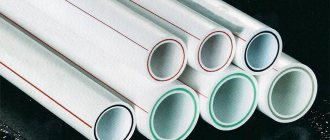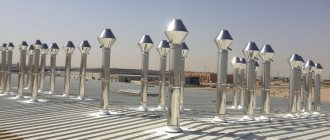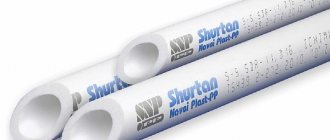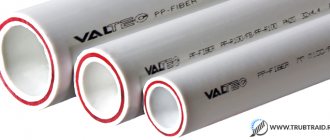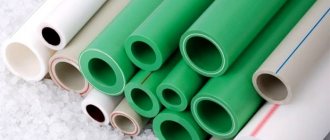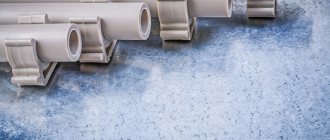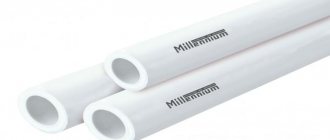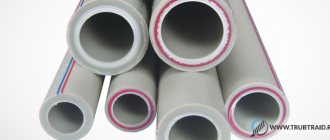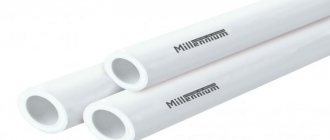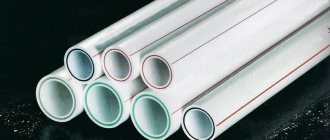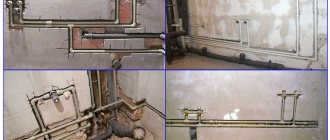To improve the mechanical properties and performance characteristics of polypropylene pipes, reinforcement is used. Reinforced polypropylene pipe retains all the positive qualities of a plastic product and acquires additional advantages - rigidity, resistance to temperature and pressure. Polypropylene is reinforced with fiberglass or aluminum. Each type of pipe has its own advantages, installation details, and operating features.
general characteristics
Pipes reinforced with glass fiber create serious competition with analogues reinforced with aluminum foil. Such risers are characterized by a three-layer structure: polypropylene - fiberglass - polypropylene. The reinforcing layer is also made from propylene, reinforced with fiberglass - glass fibers. In terms of its technical parameters, the adhesion of plastic to glass fibers can be compared to the strength of a monolith.
Glass fiber reinforced pipes are characterized by the following marking: PPR-FB-PPR.
If we compare risers with aluminum and fiberglass frames, the first option has one significant advantage: the products have greater rigidity. This means that when installing systems 1.5 meters long or more, such risers must be secured to the walls with special fasteners. Otherwise, sagging, deformation, and failure of the structure are possible.
Regarding diameters, it should be noted that products can be produced with diameters from 20 mm to 110 mm. It is these risers that can be found on sale more often than others. Although, for example, elements with a diameter of 17 mm or less are used to install heated floors.
Products of small diameters are secured with plastic clips, and large ones with clamps.
Top reinforcement
The first type of reinforcement is reinforcement of a polypropylene pipe from above.
The aluminum layer does not add strength to the pipe, because it is not an aluminum tube in a polypropylene pipe,
and aluminum foil on a polypropylene pipe.
But the aluminum layer solves the problem of linear elongation of the pipe when heated. If without reinforcement a meter of polypropylene pipe can spread by almost 12 mm, then under the same conditions a pipe with an aluminum layer will spread by only 2 mm.
Aluminum and polycom simply cannot be joined together.
Why? See the first paragraph of the PP course, where I talked about the properties of polypropylene.
It is for this reason that aluminum foil is glued to polypropylene. We get a layer of polypropylene, then a layer of glue, a layer of aluminum, then a layer of glue and another layer of polypropylene.
Aluminum foil is either overlapped or butt welded. A regular polypropylene twenty has an outer diameter of 20 mm, and a reinforced pipe with an outer layer of aluminum has a larger diameter.
So, for docking, this larger diameter must be turned into 20. That is. remove the outer aluminum layer. You will learn more in the following posts about polypropylene.
This reinforcement prevents the pipe from spreading too much when heated. But such reinforcement has a small drawback.
Over time, swelling may form in some areas of the pipes. Outwardly, this is very scary. It seems that a little more and the pipe will burst with all the consequences, but in reality this is not the case.
Only the outer layer of polypropylene swells relative to the aluminum layer. Even manufacturers allow such swellings and this in no way affects the strength of the pipe. Because the main polypropylene layer that is inside remains thick and undamaged.
These blisters can form over time due to residual moisture during pipe production. It turns out that there is no need to be afraid of this. The system will continue to work properly, with the only difference being that the appearance of the pipe is no longer at all presentable. Many users did not like this situation at all, and then the manufacturers began to think, what can be done about it?
Polypropylene products
The technical characteristics of glass fiber reinforced polypropylene pipes depend on the polymer used for their manufacture. All products are marked, which makes it possible to immediately determine the areas of use of tubular parts.
Let's find out what the markings on the pipes mean. So, PPR is an English name, and PPR is a Russian name meaning that this is a Polypropylene pipe made from Random copolymer.
Such fiberglass-reinforced polypropylene pipes are used for heating, water supply systems, ventilation systems, and industrial pipelines.
When arranging utility networks, fiberglass-reinforced PPR pipes are increasingly being used. There is nothing strange in this, since they are reliable, quite lightweight, and there are significantly fewer problems with their installation.
Another important factor is cost. For example, the price of PPR pipes reinforced with glass fiber for heating is lower than their metal counterparts, which helps save the family budget. These, as well as other characteristics possessed by fiberglass-reinforced polypropylene pipes, contributed to its popularization and use in various spheres of the national economy.
With this article read: Main characteristics and scope of application of polypropylene pipes, diameter and what influences its choice. Classification by pressure and composition of raw materials. Polar questions and answers to them.
Glass fiber reinforcement
Fiberglass is a fiber made from thin strands of glass. There is an elastic fiberglass fabric that is quite durable. I think you have met her more than once. So, glass fibers were mixed into polypropylene. We obtained polypropylene mixed with fiberglass.
As a result, this polypropylene pipe with fiberglass was glued inside a regular polypropylene pipe. The result is a polypropylene pipe with fiberglass, which is located inside the polypropylene pipe.
The linear elongation of such pipes is greater than that of those reinforced with aluminum foil. But less than without reinforcement and is only 2.5 mm. The difference with aluminum at 10 m at a temperature delta of 80° will be only 4 mm.
What types of polymer pipes are there?
Currently, 2 types of polymer products are known:
- single-layer;
- multilayer.
What characteristics do each type of product have?
Single layer
There are 4 modifications of polypropylene risers of one-piece construction, used for heating or water supply.
1st type: PPN pipes.
Homopolypropylene is used for their production. They are used in engineering pipeline structures for supplying cold water, arranging ventilation, and industrial pipelines.
2nd type: RRV pipes.
The basis for production is polypropylene block copolymer. The products are intended for installation of underfloor heating and cold water supply networks.
3rd type: PPR pipes.
The material for the production of parts is random polypropylene copolymer. The main property of the substance: promoting uniform distribution of loads on the internal walls of pipelines.
Hot and cold water supply, underfloor heating systems, water radiator heating - this is a list of applications for risers of this type.
4th type: PPs pipes.
The main characteristics of the products: polypropylene with increased heat resistance is used for production.
The parts of such a line are able to withstand temperatures of transported media up to +95⁰С. If necessary, it is possible to transport media with temperatures up to +110⁰C for a short period of time.
The first three analogues are designed to operate at temperatures around +70⁰С. In short-term mode, operation is allowed at slightly higher temperatures.
Products of the 3rd type are covered with a special shell, which can completely eliminate the negative effects of ultraviolet radiation.
Important! You should not often use the system operation in the maximum permissible parameters mode.
About multilayer analogues
Polypropylene (PP) pipes consisting of several layers are reinforced with fiberglass and are used for heating and water supply. Compared to solid cast structures, PP products practically do not change their linear dimensions at high temperatures of the transported media. Thanks to this property, the scope of application of solid-cast communications is significantly expanding.
The following modifications of multilayer risers can be distinguished.
1. Products for the reinforcement of which perforated aluminum foil is used.
They are characterized by the presence, on the outer or middle layer, of small diameter holes in the form of a mesh. The strength of the connection with the polymer is achieved due to the viscosity and fluidity of the substance that penetrates into the holes of the aluminum layer.
Product advantages
- Low coefficient of linear expansion;
- increased strength.
Minuses
- During the welding process, it is quite reliable to connect only the top layer of the riser to the fittings;
- aluminum reinforcement must be removed before welding, since failure to perform this operation may cause a poor-quality connection.
PP pipes with reinforcement in the form of solid aluminum foil.
The foil can be located both on the outer and on the middle layer of the pipe part, but it is imperative that polymer layers are placed on both sides of the metal.
Before you start welding, you need to trim the risers. Thanks to the procedure, the possibility of contact of aluminum with a moving medium is eliminated.
Advantages
- Low coefficient of thermal expansion;
- increased strength properties.
The disadvantages include:
- not all layers are welded reliably. In welding areas, only the outer layer is absolutely reliable;
- mandatory removal of unnecessary aluminum residues, which takes a lot of time.
Important! To remove the aluminum layer before welding, you need to use a special tool. Its purpose: to accurately measure the depth to which the pipes should be lowered into the fittings in order to clean the inner surface to the same distance.
Failure to comply with this condition can lead to an unreliable connection, which is fraught with the occurrence of electrochemical processes when the foil comes into contact with water.
Some enterprises have mastered the production of communications of this type, the design of which does not provide for preliminary cleaning before welding.
PP products with polyethylene reinforcement.
That is, the outer layer of the pipe looks like a thick polyethylene layer.
Advantages
- Low coefficient of thermal expansion;
- no cleaning required before joining by welding;
- operation at high temperatures.
Minuses
- When joining, a reliable connection of the fitting is possible only with the outer layer;
- full contact of the transported medium and polyethylene is not excluded;
- strength characteristics want to be the best, since the layers are connected to each other using glue.
PP pipe with glass fiber reinforcement.
Design feature: the presence of a middle polypropylene layer filled with fiberglass. Fillers are often colored to make them better visually distinguishable.
The advantages of this type of communication are greater than those of previous analogues combined.
Firstly:
structures with pipes reinforced with fiberglass for heating or water supply are highly durable and solid.
Secondly:
Fiberglass-reinforced risers are characterized by a relatively low coefficient of thermal expansion, which is approximately 25% less than that of non-reinforced counterparts.
Third:
Before hot joining, there is no need to clean the ends of the elements being connected.
Fourth:
The fiberglass line has increased rigidity.
Fiberglass elements have one drawback, and even that has not yet been fully proven: the penetration of oxygen through the material.
If this fact is fully confirmed, an accelerated process of corrosion of the metal from which the boilers are made is possible.
Theoretically, such a disadvantage is possible, but in practice, research is still being carried out.
Application areas of flexible polymer reinforced pipes
Flexible high-pressure polymer-reinforced pipes can be used:
- as stationary pipelines for oil, gas, methanol and other liquid and gaseous abrasive and aggressive media;
- as a temporary pipeline during repair work and in other cases when the construction of a permanent pipeline is not necessary. The PAT design can withstand up to one hundred cycles of unwinding it from the transport drum;
- for the organization of free-flow, pressure and high-pressure water pipelines for transporting formation and waste water;
- as flow pipelines of wells;
- for piping gas distribution stations and organizing gas distribution pipelines;
- as pipelines for water fire extinguishing systems and much more.
If you have any questions about our products, you can ask them to our managers by phone: +7 48751 510 52 and tel: +7 48751 205 55, email or through the “Get a consultation” form
How elements are connected to each other
PPR pipes reinforced with glass fiber can be joined into a single structure by diffusion welding or fittings (adapters, couplings, tees and other parts).
Each method uses a special soldering iron, the so-called welding machine. The risers joined in this way create a monolithic, non-demountable structure.
The presence of special adapters in the form of threaded or flanged connections makes it possible to fasten a PPR polypropylene pipe reinforced with glass fiber to a metal line corresponding to the fittings.
What is a fiberglass reinforced polypropylene pipe?
These products are 3-layer polypropylene pipes reinforced with FIBER glass fiber.
They differ:
- increased resistance to corrosion processes and chemical influences;
- abrasion resistance;
- hygiene. Thanks to this property, the products have found their application in the installation of drinking water pipelines;
- environmental safety;
- long service life;
- ease of installation.
In addition, the products are universal in their use.
This is manifested in the fact that they are used:
- when installing heated floors, water heating;
- for supplying hot and cold water;
- in the process of arranging drainage and sewer systems.
Due to the design features of the risers, the product practically does not change its linear dimensions, which is very important when installing heating and ventilation communications.
Technical parameters of operation
Even plastic materials reinforced with an additional layer have limitations in operating conditions. They can be used for cold and hot water supply and for installation of a heating system that runs on water. Such materials are not suitable for steam heating circuits.
The technical capabilities of the product are encrypted in its labeling. The material composition markings are given above. Imported pipes may have the following material indications:
- Stabi – aluminum;
- Fiber - fiberglass.
The diameter marking simultaneously indicates the maximum withstand pressure in kgf/sq. cm.
Characteristics and use:
- PN 10. Maximum permissible temperature up to 45 degrees. Used for installation of cold water supply pipelines and heated floor installations.
- PN 16. Temperature - 60 degrees, pressure 16 atmospheres. It is rarely used in the equipment of private houses. Purpose – cold and hot (limited) water supply.
- PN 20. Hot water supply. The permitted temperature threshold is up to 95 degrees, the recommended 80 degrees. Maximum pressure 20 atm.
- PN 25 (reinforced). Installation of heating systems of any level. Temperature 95 degrees, pressure 25 atm.
We recommend that you read: Replacing old pipes with polypropylene on your own
How to choose the right one
This question is asked by everyone who deals with the arrangement of pipe structures during repairs or when building a new house. The main thing is that the planned highway is of high quality and cheap.
To optimally resolve the issue, you need to have knowledge of the technical characteristics of the system that you plan to build.
Experts advise adhering to certain recommendations regarding other characteristics, the main ones being:
- diameter;
- pressure;
- manufacturers.
And then - in more detail.
Required diameters.
Today's market is saturated with products with diameters of 20-110 mm.
In everyday life, elements with a diameter of up to 40 mm are most often used. Risers of this thickness are used in the installation of heating, ventilation systems, hot and cold water supply.
In some cases, the most accurate calculations are needed when installing certain communications. In such situations, it is necessary to use the services of specialists who, using formulas, will make the necessary calculations. Taking into account the maximum water flow rate and the speed of its movement, professionals will tell you as accurately as possible what diameter riser should be used in a given case.
What pressure are the parts designed for?
To a person not familiar with the specifics of such work, the task of choosing a riser that can withstand a certain pressure seems quite difficult. But this is at first glance. In fact, the problem is easily solved.
To do this you need: to know what pressure the heating or plumbing system is designed for and... to be able to read. This means that since all glass fiber reinforced PPR pipes are marked, it contains all the information about the product. That's where it says what maximum pressure the product is designed for.
Mostly, in everyday life, communications with the inscription PN20 are used, which means that the part can be used in lines with a pressure of up to 20 atm. This number is exaggerated, since such pressure is not observed in household lines. For example, in heating systems of one-story buildings, the nominal pressure is 2.5 - 4 atmospheres. But a margin of safety won't hurt.
Regarding the diameter, it is necessary to select the appropriate fittings.
Important! The optimal option for selecting pipes and fittings is to have parts not only of the same diameter, but also of the same manufacturer. When installing a structure made from such elements, minimal problems are eliminated.
Manufacturers
The correct choice of PPR risers also includes the choice of manufacturer. There is no one specific company whose products would satisfy all customers.
The question is to avoid unnecessary problems. Therefore, preference should be given to that (or those) enterprises whose reputation in the market for similar goods is impeccable.
Companies from Europe have a certain advantage in this regard. High quality, reliable operation, affordable price, which means that products from companies from Germany and the Czech Republic are popular.
In recent years, the quality of goods from Turkey and China has increased significantly.
Domestic manufacturers are slightly behind them, whose products today are distinguished not only by relatively low prices, but also by proper quality. The choice is yours. The main thing is not to buy fakes. Therefore, buy goods in branded stores, requiring a quality certificate.
In addition to these, there are other reasons that influence the choice of product. There is, however, one thing: we did not remember at all about the service life of products made from white polypropylene. There is a reason for this. Adhering to the requirements of proper operation, the elements of the pipeline structure are fully capable of withstanding the period of time needed to begin the next major renovation of the building.
These are the materials today.
Conclusion
What conclusion can be drawn about the reinforcement of PP pipes?
- Reinforcement is needed to compensate for linear elongation during heating, as can be calculated in a separate paragraph.
- The reinforcement is made of aluminum in the form of solid foil on the outside of the pipe and inside, perforated foil on the outside is a drawback; such pipes must be cleaned before welding.
- A glass or basalt reinforced pipe replaces aluminum reinforcement in water supply systems, and an additional anti-diffusion layer on top of such a pipe makes it suitable for installation of heating systems.
Based on the knowledge you have acquired, you now know exactly what goes where, and when purchasing, all you have to do is focus on quality, price and labeling, which we will talk about in the next paragraph.
